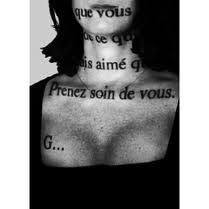IMAGE
AND TEXT
In
photography image is equally important as text. The relationship between two
can significantly change the perspective and the way we look at the composition
or a person and object within a photograph.
By adding text to the image we are able to totally overwrite the meaning of it.
For example when we look at a photograph we try to interpret the message and
purpose of it. Our thinking and view change when we start to read a text added below
the photograph by the artist. We can then see the whole concept of that image
from a different angle.
In
documentary photography it is essential how we frame the scene and overall
composition. An image doesn’t always tell the truth but it captures what we want
to.
In
a similar way the words can have another meaning depending on the image they
have been placed by.
As
a first example I would like to look at the work of English conceptual artist Gillian
Wearing. She was born in Birmingham in 1963. She has put together photography exhibitions
that were based on idea of photographing strangers in the street. They were
asked to write on the piece of paper what was on their mind. With the
permission from that person she photographed them standing on the street and
holding their personal statement. Below is one of the most known images which represents
a smartly dressed young man who looks quite calm and happy on his face. However
the signs he is holding says ‘’I’m desperate” which completely changes our interpretation
and a meaning of that photograph.
Another
image again shows a young man who is dressed a little bit scruffy. His face looks
like he could have been on drugs or drunk. Also the background of that image
looks very dingy. On the attached sign we can read his thought ,,I signed on
and they would not give me nothing”. It gives a twist to the overall image and
forces us to think about the story of that man. Why he feels and looks like
that? Maybe someone or something made him to feel like that? Maybe he is not
drunk but very upset...?
The
next artist whose work I found inspirational is Sophie Calle. A French writer
and photographer who uses in one of her series of images a projector to overlap
a text with a photographed person.
Below
I have included some of my photographs which incorporate with the text.
Image source
http://artwednesday.com/2012/05/13/whitechapel-x-gillian-wearing/
http://www.tate.org.uk/art/artworks/wearing-i-signed-on-and-they-would-not-give-me-nothing-p78350
http://eighteen39.com/2011/06/10/friday-feature-sophie-calle/
http://artwednesday.com/2012/05/13/whitechapel-x-gillian-wearing/
http://www.tate.org.uk/art/artworks/wearing-i-signed-on-and-they-would-not-give-me-nothing-p78350
http://eighteen39.com/2011/06/10/friday-feature-sophie-calle/




























